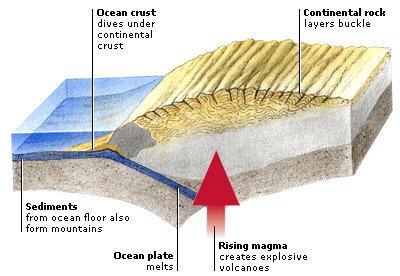DK Science: Mountain Building
New mountains are built when rocks are pushed upwards by the movement of the giant rocky plates that make up the Earth’s crust. The rocks are pushed upwards in two ways: FOLD mountains are formed when layers of rock become buckled, and BLOCK mountains are formed when giant lumps of rock rise or fall. Volcanic eruptions also create mountains. Many mountain ranges have been built up and eroded away since the Earth was formed.
The Andes is the longest mountain range on land. It was formed along the western margin of South America, where two tectonic plates (rocky plates that make up the Earth’s crust) collided. The mountains are still rising by about 10 cm (4 in) every century.

Fold mountains are pushed up at a boundary where two tectonic plates collide. The boundary between an ocean plate and a continental plate is called a subduction zone. Here, the thin ocean crust slides slowly under a thicker continental crust, making the rocks buckle and fold. The ocean plate also melts, creating magma (molten rock) that rises to form volcanoes.
The world’s major mountain ranges, such as the Andes, the Himalayas, and the Alps, are situated along the boundaries where tectonic plates collide. These ranges formed in the last few hundred million years, so are they quite young. The map also shows thin lines of volcanoes that erupt from the ocean floor, forming chains of mountainous islands.
The Himalayas is a range of fold mountains formed by the collision between India and the rest of Asia. When the two tectonic plates collided, the southern edge of Asia buckled. The Indian plate continues to slide under Asia and, to date, has uplifted Tibet to a height of over 5 km (3 miles).
When layers of rock are pushed inwards from both ends, they crumple up into waves called folds. Rocks are too hard to be squashed into a smaller space. Instead they fold upwards and downwards. The immense forces that cause folding can crunch solid rocks into folds just a few metres across.
The rocks that buckle to form fold mountains are made up of layers of sedimentary rocks and igneous rocks. When the layers are folded, the rocks on the outside of a fold are stretched and the rocks on the inside of a fold are squashed. The folding also makes the layers of rock slide over each other.
Block mountains are mountains formed when layers of rock crack into giant blocks. Cracks in layers of rock are called faults. They form when the Earth’s crust is stretched, squashed, or twisted. The blocks are free to slip up, down, or sideways, or to tip over. These movements are very slow, but over millions of years they form mountains thousands of metres high.
